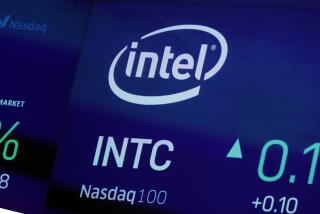Intel Makes Down Payment on Leadership Role in ‘90s
- Share via
In the teeth of recession, Intel Corp. announced recently that it would boost investment in plant and equipment by more than 20% this year to between $800 million and $1 billion. And such heavy spending will be maintained for several years, Chairman Gordon Moore says.
That’s quite a commitment for a medium-sized company that last year had $4 billion in total sales and $650 million in profit.
But it was the action of a winner. The Santa Clara, Calif., company leads the world in the complex semiconductors called microprocessors that are the heart of today’s personal computers--Intel chips provided computing power to 64% of the 22 million PCs sold in the world last year. With almost half of its sales coming from overseas, Intel is attaining a stature akin to that of Boeing or IBM as a U.S. industrial bulwark.
Even the stock market is impressed. Intel stock is up 10% since the investment announcement, a big change from 1984 when the company announced a similar spending increase and investors sent its stock into a two-year, 40% decline.
“Investors in the 1980s feared that foreign competition would push U.S. semiconductor and computer companies out of business,” says analyst Andrew Kessler of Morgan Stanley, but now they feel more confident that U.S. firms can hold their own. That’s one reason Intel, IBM and other technology stocks have been strong lately.
Investors happen to be right, but it’s doubtful whether they or the general public understand the full challenge of global competition and constant technological change that Intel and the computer industry are meeting.
Intel’s President Andrew Grove--who came to the United States from the Hungarian revolt in 1956 and worked his way through New York’s City College and the University of California, Berkeley--believes that the U.S. computer industry is in dire peril. His job, Grove says, is to see that his company survives.
To do that, Intel spends more than its American or Japanese competitors on research and on plant and equipment. Its strategy is to present a moving target.
The new spending campaign, for example, will make it hard on competitors who are beginning to copy Intel’s most successful microprocessor, the 386. But Intel won’t respond simply by cutting prices. Rather, it will turn out several versions of a new, more powerful microprocessor, the 486. It will then sell a product with four times the computing power for less than twice the price of the 386.
By 1992, Intel will bring out a new microprocessor, the 586, with four times the power of the 486. And so on until the end of the decade when it will produce a single semiconductor with 100 million transistors. That will make possible supercomputers the size of notebooks, at prices per unit of computing power far below today’s levels.
What we’re witnessing is a technological revolution causing a business one. Because there is a doubling every 18 months or so in the amount of electrical circuity--and thus power--that chip makers here and abroad can etch on a wafer of silicon, product life cycles blur for automobiles, video machines and computers themselves. Companies that thought in traditional ways of stable products and predictable profitability, are now casualties or nearly so--Chrysler, RCA, Burroughs and Sperry (now combined as the ailing Unisys), Control Data and others.
The cost of computing power has come down 90% in the past five years, Grove says, and in future, performance will rise and prices will fall at a “hair-raising rate.”
The payoff for world industry is in productivity. Even today, Intel produces a supercomputer by putting a lot of high-powered chips to work in parallel on different aspects of a problem. Intel sold such a supercomputer recently to Mitsubishi, which can use it to model the flow of air over airplane wings, says Gary Smaby, a Minneapolis-based supercomputer consultant. That duplicates the action of a wind tunnel, which costs about $100 million to build. But the Intel supercomputer costs only about $1 million. The saving of resources and money is enormous--the gain in productivity immense.
The payoff for Intel is a decade of challenge and opportunity. Demand for investment will be constant as computing moves beyond text and numbers to images.
Intel can handle it because it has reinvested profits and husbanded cash--it has $1.7 billion. It pays no dividends but earns a 16% to 20% return on every invested dollar, and its stock has gone up an average of 40% a year for the past five years.
Recognition is spreading. Computer consultant Richard Shaffer, editor of the Technologic Computer Letter, says Intel, along with IBM and software maker Microsoft, have secured leadership of the world computer industry for the decade.
Grove doesn’t use words like secure. Rather he criticizes the U.S. government’s lack of a policy to support the domestic computer industry--”We are becoming, technologically speaking, a less developed country,” he says provocatively--and looks for survival overseas, where the computer business is growing faster.
The new spending program will expand a plant in Ireland to serve Europe. Undoubtedly a major facility will be built in Asia, where Intel microprocessors power all of Japan’s personal computers--which means that Intel faces competition if Japanese customers develop their own microprocessors.
You play it as it lays, Grove says. “The action in our industry is moving to Japan, so we improve our skills and our sales efforts follow it.”
Not an entirely reassuring picture, save that it shows a smart U.S. company thinking like a world company to survive. And that U.S. investors are backing Intel’s commitment is another encouraging indicator that the ‘90s will be a decade of values, in more ways than one.
More to Read
Inside the business of entertainment
The Wide Shot brings you news, analysis and insights on everything from streaming wars to production — and what it all means for the future.
You may occasionally receive promotional content from the Los Angeles Times.










